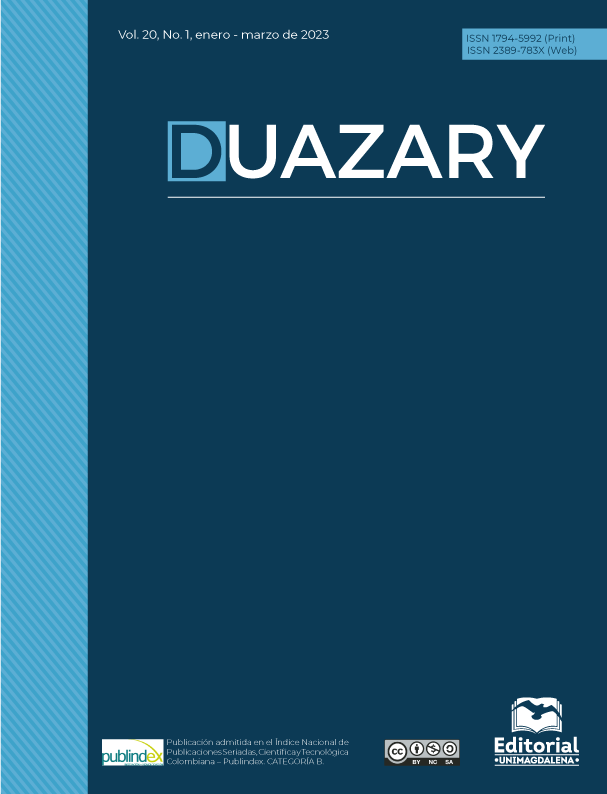Abordaje interdisciplinario de lesión periapical confluyente que involucraba el seno maxilar: reporte de un caso
Contenido principal del artículo
Resumen
La interdisciplinariedad en los diagnósticos y tratamientos de lesiones periapicales de gran tamaño en los maxilares es fundamental para el pronóstico favorable y conservación de órganos dentales. El presente caso exhibe a los granulomas apicales a consecuencia de enfermedades endo-periodontales crónicas y de inadecuados manejo e inoportunos diagnósticos. Es así como también fueron aplicadas herramientas como tomografía cone-Bean, histopatología e inmunohistoquímica jugando un rol fundamental en la intervención de las mismas para un diagnóstico certero. El objetivo del presente caso fue describir un abordaje interdisciplinario de lesión periapical confluyente que involucraba el seno maxilar, el cual evolucionó de manera satisfactoria.
Descargas
Detalles del artículo

Esta obra está bajo una licencia internacional Creative Commons Atribución-NoComercial-CompartirIgual 4.0.
No se permite un uso comercial de la obra original ni de las posibles obras derivadas, la distribución de las cuales se debe hacer con una licencia igual a la que regula la obra original.
Citas
Syed Ismail PM, Apoorva K, Manasa N, Rama Krishna R, Bhowmick S, Jain S. Clinical, radiographic, and histological findings of chronic inflammatory periapical lesions - A clinical study. J Family Med Prim Care. 2020;9(1):235-238. https://doi.org/10.4103/jfmpc.jfmpc_715_19
Kharat N, Waghmare P, Sarkar M, Nawal S, Sahu T, Dheeraj M. Assessment of Constant Periapical Lesions and Their Connection with Endodontic Failures after Apical Microsurgery. J Pharm Bioallied Sci. 2020;12(Suppl 1):S233-S237. https://doi.org/10.4103/jpbs.JPBS_68_20
Dumitrescu A, Martu MA, Nemtoi A, Sirghe A, Chelaru L, Tatarciuc D, Dumitrescu AM, Haba D. Association between Cone-Beam Computed Tomography and Histological and Immunohistochemical Features in Periapical Lesions Correlated with Thickened Maxillary Sinus Mucosa. Medicina (Kaunas). 2021;19;57(8):840. https://doi.org/10.3390/medicina57080840
Vidal F, Coutinho TM, Carvalho Ferreira D, Souza RC, Gonçalves LS. Odontogenic sinusitis: a comprehensive review. Acta Odontol Scand. 2017;75(8):623-633. https://doi.org/10.1080/00016357.2017.1372803
Tsesis I, Rosen E, Beitlitum I, Dicker-Levy E, Matalon S. Influence of the Periapical Status of the Posterior Maxillary Teeth on the Width of the Schneiderian Membrane of the Maxillary Sinus Mucosa. Applied Sciences. 2021; 11(9):3908. https://doi.org/10.3390/app11093908
Gürhan C, Şener E, Mert A, Şen GB. Evaluation of factors affecting the association between thickening of sinus mucosa and the presence of periapical lesions using cone beam CT. Int Endod J. 2020;53(10):1339-1347. https://doi.org/10.1111/iej.13362
Vestin Fredriksson M, Öhman A, Flygare L, Tano K. When Maxillary Sinusitis Does Not Heal: Findings on CBCT Scans of the Sinuses With a Particular Focus on the Occurrence of Odontogenic Causes of Maxillary Sinusitis. Laryngoscope Investig Otolaryngol. 2017;2(6):442-446. https://doi.org/10.1002/lio2.130
Fuentes R, Álvarez G, Arias A, Borie-Echevarría E, Dias F. Periodontitis Apical: Caracterización Histológica y Morfométrica de Quistes Radiculares y Granulomas Periapicales. Int. J. Morphol. 2018; 36(4): 1268-1274. Disponible en: http://dx.doi.org/10.4067/S0717-95022018000401268.
Villarreal-Arango D, Ramos-Manotas J, Díaz-Caballero A. Apicectomía y obturación retrógrada como tratamiento de granuloma periapical. Reporte de caso. Rev Fac Odontol Univ Antioq 2016;28(1): 203-209. http://dx.doi.org/10.17533/udea.rfo.v28n1a11
Kharat N, Waghmare P, Sarkar M, Nawal S, Sahu T, Dheeraj M. Assessment of Constant Periapical Lesions and Their Connection with Endodontic Failures after Apical Microsurgery. J Pharm Bioallied Sci. 2020;12(Suppl 1):S233-S237. http://doi.org/10.4103/jpbs.JPBS_68_20
Love RM, Firth N. Histopathological profile of surgically removed persistent periapical radiolucent lesions of endodontic origin. Int Endod J. 2009;42(3):198-202. http://doi.org/10.1111/j.1365-2591.2008.01500.x
Syed Ismail PM, Apoorva K, Manasa N, Rama Krishna R, Bhowmick S, Jain S. Clinical, radiographic, and histological findings of chronic inflammatory periapical lesions - A clinical study. J Family Med Prim Care. 2020;9(1):235-238. Published 2020 Jan 28. http://doi.org/10.4103/jfmpc.jfmpc_715_19
Juerchott A, Pfefferle T, Flechtenmacher C, Mente J, Bendszus M, Heiland S, Hilgenfeld T. Differentiation of periapical granulomas and cysts by using dental MRI: a pilot study. Int J Oral Sci. 2018;10(2):17. http://doi.org/10.1038/s41368-018-0017-y
Weber M, Schlittenbauer T, Moebius P, et al. Macrophage polarization differs between apical granulomas, radicular cysts, and dentigerous cysts. Clin Oral Investig. 2018;22(1):385-394. https://doi.org/10.1007/s00784-017-2123-1
Bănică AC, Popescu SM, Mercuţ V, et al. Histological and immunohistochemical study on the apical granuloma. Rom J Morphol Embryol. 2018;59(3):811-817. Disponible: https://pubmed.ncbi.nlm.nih.gov/30534820/

